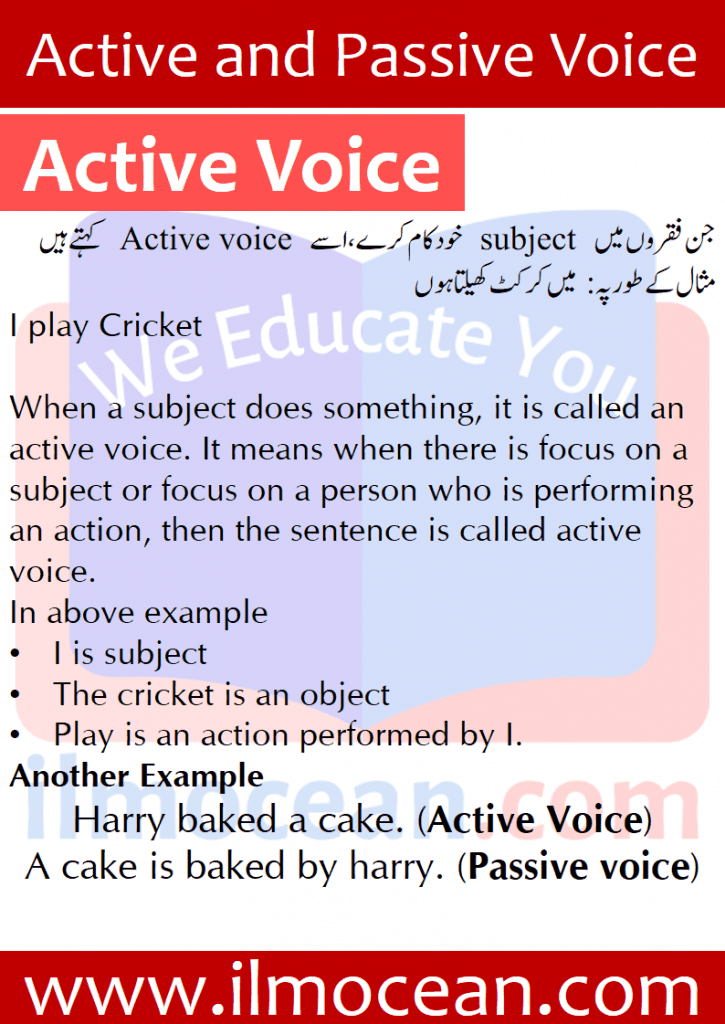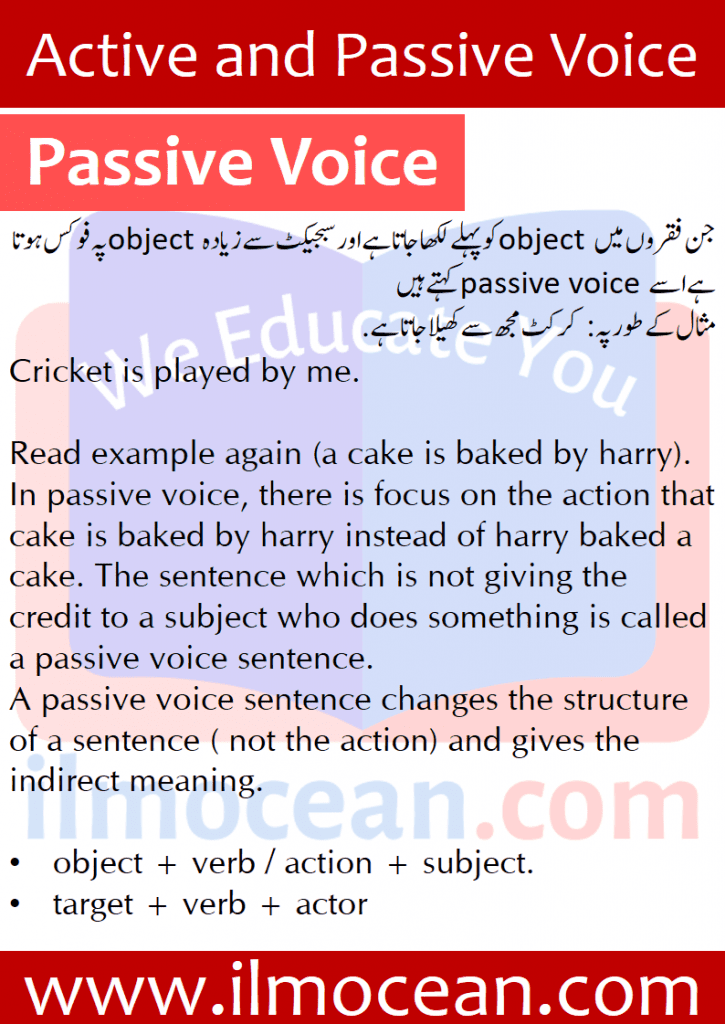Multilingualism is becoming more and more important in today’s world. From a study interview to a job interview, being able to speak in a foreign language helps to convey your message in a clearer form. Out of 6500 languages, English is the 3rd most widely spoken language. English is most widely spoken and taught in more than 118 countries. It is becoming the official language of trades or diplomatic language. Last but not the least, it is the international communication language of media and the internet. Do you want to pass your exams or clear your job interview? Do you want your skills to become the source of your income? If yes then first learn active and passive voice.
Verbs have five properties in English grammar: voice, mood, tense, person, and number; here, our concern is about voice. These two voices are active voice and passive voice. It may sound weird to hear those written sentences have voices, and even more strange to hear that there are debates on these two voices which are active voice and passive voice. The correct use of voice is very important especially while you are conveying someone’s action or writing an article or describing your action.
Before learning active voice and passive voice, we are going to clear our concept about sentence voice. Voice refers to the connection between an action of a subject in relation to an object. These two ways of expressing an action of a subject are called voices.
These voices are:
- Active voice
- Passive voice
After reading this article, you are going to become an expert in active voice and passive voice.
In this article we are going to learn:
- What is active voice?
- What is passive voice?
- At what time active voice and passive voice used.
- Importance of active voice over passive voice
- How to convert passive voice sentences to active
- Examples of active voice and passive voice.
There is an example of active voice and passive voice.
- Harry baked a cake. (Active Voice)
- A cake is baked by harry. (Passive voice)
What is active voice?
جن فقروں میں subject خود کام کرے ، اسے Active voice کہتے ہیں
مثال کے طور پہ : میں کرکٹ کھیلتا ہوں
(I play Cricket)
When a subject does something, it is called an active voice. It means when there is focus on a subject or focus on a person who is performing an action, then the sentence is called in active voice.
In above example
- Harry is subject
- The cake is an object
- And baked by is an action performed by harry.
Subject + verb / action + object.
Actor + verb + target
If we read the sentence again (harry baked a cake), we can feel there is a focus on harry that harry baked a cake. So, when a subject performs an action, this sentence is called the active voice.
Sentences in active voice have strong, clear, and direct meaning and tone.
What is Passive Voice?
جن فقروں میں object کو پہلے لکھا جاتا ہے اور سبجیکٹ سے زیادہ object پہ فوکس ہوتا ہے اسے passive voice کہتے ہیں
مثال کے طور پہ : کرکٹ مجھ سے کھیلا جاتا ہے
Cricket is played by me
When the subject is acted upon by an object or action, it is called the passive voice.
If we read the example again (a cake is baked by harry).
In passive voice, there is focus an action that cake is baked by harry instead of harry baked a cake. The sentence who is not giving the credit to a subject who does something is called a passive voice sentence.
A passive voice sentence changes the structure of a sentence (not the action) and gives the indirect meaning.
object + verb / action + subject.
target + verb + actor
in comparison to active voice and passive voice, the vast majority in writing prefer to write in active voice as an active voice has direct and strong meaning instead of passive voice.
When to use active voice and passive voice?
Active voice conveys a strong meaning and have a clear tone. On the other side passive voice is indirect, feebler and weaker. Good advice is don’t use the passive voice just because you think it sounds fancier than the active voice.
A good rule of thumb is to put the majority of your sentences in the active voice, unless you truly can’t write or define your sentence in any other way.
Importance of Active voice over Passive voice?
Sentences written in active voice are easy to understand and give the exact and clear meaning of the sentence. Let’s consider an example
- Harry killed a lizard
- A lizard was killed by Harry
In passive voice, the main focus is on the action. It is not important who have or had performed that action.
If we read the active voice example again (Harry killed a dog). It is clearly giving the meaning that Harry is the person who killed the dog.
Now read the passive voice example again (Dog was killed by harry). This sentence’s main focus on the murder of the dog, not on the person who killed the dog. Although both sentences of active voice and passive voice meanings are the same but sentence wattage has been changed.
How to convert Passive voice to Active Voice?
Earlier we have learned:
Active Voice = Subject + Verb + Object
Passive Voice = Object + Verb + Subject
The following rules are applied for the conversion of passive voice sentence into active voice sentence.
Example:
Passive Voice: A ball was kicked by me.
Active Voice: I kicked the ball.
- Find the subject of sentence. (I)
- Find the object of sentence. (ball)
- Find the verb of sentence. (kicked)
- Replace the object of sentence with subject of sentence. (A ball was kicked… to I Kicked )
- Re-write the sentence and change the tense if needed.
| Tense | Active voice | Passive voice | Active sentence | Passive equivalent |
| Simple present | write | is written | Alia writes a letter | A letter is written by Alia. |
| Present continuous | is writing | is being written | Alia is writing a letter | A letter is being written by Alia. |
| Simple past | watched | was watched | I watched a drama yesterday | A drama was watched by me yesterday. |
| Past continuous | was watching | was being watched | I was watching a movie. | A movie was being watched by me yesterday |
| Present perfect | have kept | have been kept | I have kept all your old books. | All your old books have been kept. |
| Past perfect | had kept | had been kept | He had kept up his training for a month. | His training had been kept up for a month. |
| Simple Future | will keep | will be kept | I will keep your secretes | Your secrets will be kept by me. |
| Conditional Present | would keep | would be kept | If you tell me, I would keep your secret. | If you told me, your secret would be kept. |
| Conditional Past | would have kept | would have been kept | She would have kept your secrets | Your secrets would have been kept by herself |
| Present Infinitive | to keep | to be kept | She wants to keep the book. | The book wants to be kept. |
| Perfect Infinitive | to have kept | to have been kept | Do yourself (exercise) | Do yourself (exercise) |
| Present Participle | keeping | being kept | Do yourself (exercise) | Do yourself (exercise) |
| Perfect Participle | having kept | having been kept | Do yourself (exercise) | Do yourself (exercise) |






